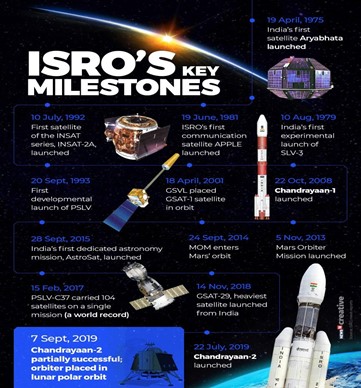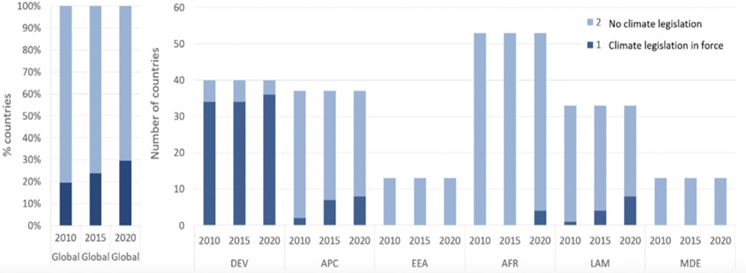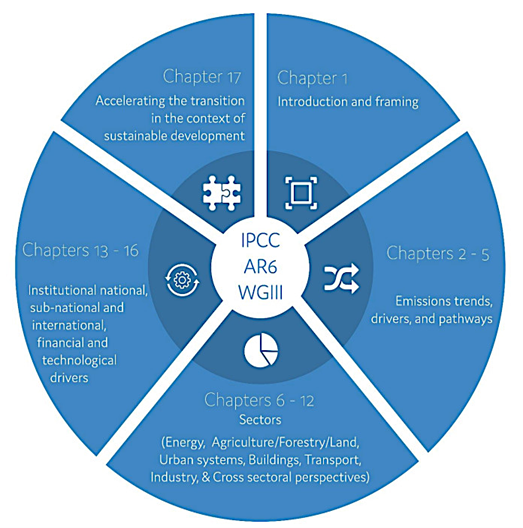10 Jan
Climate change and rising temperature: Need for long term strategic plan for mitigation
In news: India submits its Long-Term Low Emission Development Strategy to UNFCCC
Background: Earth’s temperature has risen by 0.08° Celsius per decade since 1880, but the rate of warming since 1981 is more than twice of that: 0.18° C per decade. 2021 was the sixth-warmest year on record based on NOAA’s (National Oceanic and Atmospheric Administration) temperature data.
Climate Change Related Events Across The Globe
- Warming Temperatures: Middle of continents are expected to be warmer than coastal areas. The Arctic is heating up about twice as quickly as the global
- Changing Regional Precipitation: With increasing temperature,global average precipitation will also increase in low and mid latitude regions by the end of century.
- Rising Seas Levels: Low-lying coastal regions and small islands in Pacific will be subjected to more frequent flooding or even permanent inundation
Extreme Events
- Hurricane Prone Regions:Hurricanes may start earlier and end later. Theybecomemoreintenseasseasurfacetemperatures
- High Mountain Regions: Shrinking glaciers threaten the extinction of species and High altitude ecosystems.
- Regions Affected by El Niño and Other Patterns in the Atmosphere: El Niño & La Niña events along with seasonal monsoons may change eventually affecting millions of people in areas like India and
- The Polar Regions: The extent of sea ice in the Arctic Ocean has been decreasing Glaciers and ice sheets in Antarctica and Greenland are melting too.
Climate change related events in different parts of India
- Hilly areas: About 33 per cent of the biodiversity of the Western Ghats will be lost by 2050 due to extreme weather. Forest will change from evergreen to deciduous and dry
- Northern Plains: The Ganga-Brahmaputra and Indus basins, recorded more water flowing in the river channels due to glacial melt
- Drier regions: Higher temperatures may produce an increasing number of wildfires eliminating slow-growing trees and shrubs and replacing them with fast-growing grasses.
- Islands: Sea level rise and consequent increase in intense tropical cyclones, threaten the existence of islands of India, specially Great Andaman and Nicobar
|
Reasons of climate change and rising temperature:
Natural Factors:
- Changes in the Earth’s Orbit and Rotation: Amount of summer sunshine in the Northern Hemisphere, affected by changes in the planet’s orbit, appears to be the primary cause of past cycles of ice ages.
- Volcanic Activity: Volcanic eruptions released large quantities of carbon dioxide in the distant past.
- Movement of Crustal Plates: As tectonic plates move over geological timescales, landmasses formed in tropical areas are carried to higher latitudes. Northern Hemisphere has warmed more than the Southern Hemisphere because the former has a larger percentage of Earth’s landmass compared to ocean than the
- El Niño-Southern Oscillation (ENSO): An El Niño warm-water phase changes global weather patterns. South America experiences wetterthanaverageweather,whileNorthAmericaexperiencesmildbutstormierwinter
Anthropogenic Factors
- Reflectivity or Absorption of the Sun’s Energy: Activities such as agriculture, road construction, and deforestation are changing the reflectivity of the earth's surface, leading to local warming or cooling.
- Heat-trapping Greenhouse Gases and The Earth's Climate: Concentrations of the key greenhouse gases have all increased since the Industrial Revolution due to human activities.
- Land use changes: More than half of our gross greenhouse gas emissions are from For example, livestock rearing (96%), Fertilser emission (15 % of farm’s carbon footprint)
|
How Climate Change Disproportionately Impacts the World
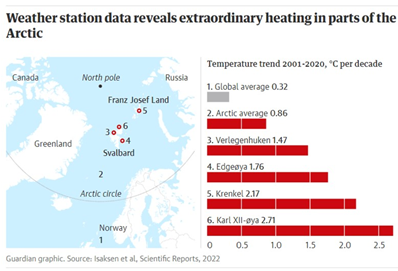
- Fragility, Conflict, and Displacement: Extreme weather has contributed to conflict and terrorism in fragile states that have led to the displacement of 80 million people from their homes.
- Food and Water Security:Of the 124 million people worldwide, 76%wereaffected byclimateshocksand extremes,according totheFood and AgricultureOrganization
- Global Health: Warmer temperatures could expose as many as one billion people to deadly infectious diseases such as Zika, dengue, and chikungunya.
- Economic Development: The World Bank estimates that the effects of climate change could push an additional 100 million people below the poverty line by 2030.
Mapping India’s Vulnerability to Increasing Temperature and Climate Change
- Tropical country: Tropical country like India is likely to face frequent cyclonic disturbances and monsoon- related
- Extreme events: Climate change is likely to make rainfall erratic, cause sea level rise, and accelerate the frequency and intensity of droughts and
- Heat waves: India suffered from one of the longest ever recorded heatwaves in 2018, with temperatures rising to 48 degree Celsius, resulting in hundreds of
- Inequality: Increasing vulnerablity to extreme heat due to low per capita income, social inequality and a heavy reliance on
- Economic losses: Exposure to rising sea levels and Changing monsoon patterns having already led to a loss of 16 per cent of its per capita GDP since 1991
Global Efforts to Counter Climate Change
|
The Intergovernmental Panel on Climate Change (IPCC) |
|
|
United Nations Framework Convention on Climate Change (UNFCCC) |
|
|
Kyoto Protocol / Paris Agreement: |
|
|
REDD ++ |
|
India’s Efforts at Global Level
|
International Solar Alliance |
|
|
One Sun, One World, One Grid |
|
|
Long Term Emission Development Strategy |
|
India’s National Efforts to Tackle Climate Change:
|
National Action Plan on Climate Change (NAPCC) |
Launched with 8 national missions forming its core
|
|
Green buildings |
|
|
National initiatives on Climate Resilient Agriculture |
|
|
FAME INDIA |
|
|
Clean Energy Cess |
|
|

Long Term Emission Development Strategy
- In the recently held, COP -27 at Sharm el Sheikh, Egypt, India’s LT-LEDS was prepared after extensive consultations with various government entities, state governments, research institutes and civil society organizations.
India Long Term Emission Strategy is based on 7 key pillars:
|
1. Low carbon development of electricity systems |
|
|
2. Integrated, efficient and inclusive low-carbon transport systems. |
|
|
3. Energy and material-efficiency in buildings. |
|
|
4. Decoupling growth from emissions and developing an efficient, low-emission industrial system, |
|
|
5. CO2 removal and related engineering solutions, |
|
|
6. Enhancing forest cover consistent with socioeconomic and ecological considerations |
|
|
7. Increasing climate resilience in poverty eradication and employment creation. |
|
Concusion:
 The two themes of “climate justice” and “sustainable lifestyles”, alongside the principles of Equity and Common But Differentiated Responsibilities and Respective Capabilities (CBDR-RC), in the light of national circumstances, that India had emphasized at Paris, are at the heart of a low-carbon, low-emissions future.
The two themes of “climate justice” and “sustainable lifestyles”, alongside the principles of Equity and Common But Differentiated Responsibilities and Respective Capabilities (CBDR-RC), in the light of national circumstances, that India had emphasized at Paris, are at the heart of a low-carbon, low-emissions future.
The LT-LEDS is also informed by the vision of LiFE, Lifestyle for the Environment, that calls for a world-wide paradigm shift from mindless and destructive consumption to mindful and deliberate utilization.
|
Mission LiFE – Lifestyle for Environment
|
Where to use it?
Paper I (Climate Change) Paper 2 (Government Policies) Paper 3 (conservation) Paper I ( Geography Optional : Global Climatic Change, Environmental Policy)
POLAR VORTEX AND THEORIES OF ARCTIC AMPLIFICATION
Why in news: Research shows that Arctic is warming four times faster than the rest of the planet Recently Arctic amplification has led to harsh winters in U.S., Summer heat waves in Europe and Floods in Pakistan.
|
ARCTIC AMPLIFICATION: Ramped up warming taking place in world , north of 67 degrees N latitude.
|
Theories of Arctic Amplification
- The different theories of how Arctic amplification could be affecting the mid-latitudes fall broadly into three main categories: those that focus on a “wavier” jet stream, the stratospheric polar vortex and “wave resonance”.
Wavier jet stream
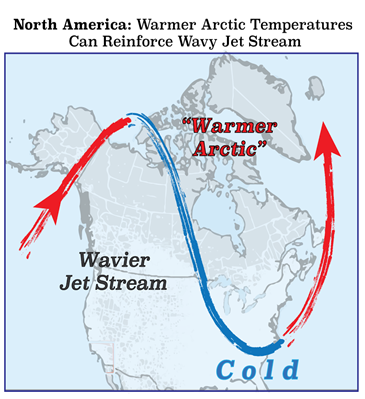
- In the UK , if the jet stream path shifts to the south, it pulls down cold air from the Arctic. When it sways north, it brings warm air up from the tropics.
- The strength of the jet stream is driven by the difference in temperature between the cold air over the Arctic to the north and the milder air to the south.
- As the Arctic is warming more rapidly than the mid-latitudes, the temperature difference is declining, which leads to a weaker jet stream.
- The weaker jet stream with diversions from its path increase the likelihood of a wavier jet stream pattern.
- When the jet stream takes larger north-south meanders – known as “Rossby waves” – warm air can penetrate north and cold air can plunge south.
Polar vortex
- As with the jet stream in the troposphere, the polar night jet forms a boundary between the very cold Arctic air and the warmer air over the mid-latitudes. However, if something disrupts the stratospheric polar vortex it can weaken, reverse direction and even split into two. This can trigger a sudden stratospheric warming (SSW) event where air collapses in over the Arctic, causing a spike in temperatures in the stratosphere – by as much as 50C in just a couple of days.
- This allows the cold air the polar vortex was holding in to spill out into the mid-latitudes during the weeks that follow. This is what brought the “Beast from the East” to the UK in 2018 and is the root cause of the dramatic weather currently hitting the US this winter.
Wave resonance
- “Wave Resonance” also relates to the jet stream in the troposphere, but only occurs during summer. It is suggested to have played a role in the European heatwave and the Pakistan floods .
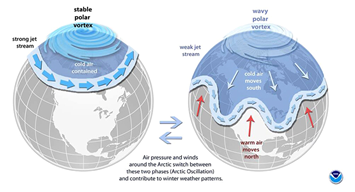
- This theory suggests that a weakened jet stream increases the likelihood of it splitting into two distinct jets. One jet then moves north and the other south, potentially trapping weather systems in between. This “quasi-resonance” results in persistent – and often extreme – summer weather.

Where to use?
Paper 1 (Important Geophysical phenomenon, Climate change) Paper 3 (Environment)
Paper I (Geography Optional : Atmospheric circulation, Jet Streams, Global Climatic Change)
Development Plan of Great Nicobar Mega Project
Why in news? Government of India has recently cleared the proposal for the deforestation of large forest land in Great Nicobar so as to carry some developmental work and planned almost twice the area for forestation in Haryana.


Great Nicobar Project
- NITI Aayog-piloted Rs. 72,000- crore integrated project in Great Nicobar which includes construction of a mega port, an airport complex, a township spread over 130 sq. km of pristine forest and a solar and gas-based power plant.
Arguments in favour of project:
- ICTT: The proposed port will allow Great Nicobar to participate in the regional and global maritime economy by becoming a major player in cargo tranship
- Attract existing traffic of ports along the eastern coast of India, Bangladesh and Myanmar.
- Greenfield International Airport: The proposed airport to be developed as a “joint military-civil, dual-use airport”, and will also cater to tourism as well.
- Township: It will link the infrastructure facilities to complete the physical framework of the new city.
- Power-Plant: Develop power through solar panels and gas.
Concerns associated with project
- Deforestation:5 lakh trees will be felled for port-township-airport-power plant project on the eastern coast of Great Nicobar Island.
- Biodiversity: Reclaiming 300 hectares from the ocean will affect marine biodiversity and also threat to nesting sites of endemic species like Leather back turtles.
- 20 hectares of mangroves will be lost and 10 hectares of corals cover be translocated from Galathea Bay.
- Indigenous communities: Shompen and Nicobarese tribe will be effected as they are prone to human induced diseases due to influx of domestic and international populations.
- Compensatory afforestation: Taken up on a “non-notified forest land” in Haryana, but not on the island where forested land will be affected.
Mitigation measures to be taken
- Compensate for coral translocation and rseef restoration in Galathea Bay.
- Re-densifying’ existing mangrove patches and planting mangroves in non-forest areas.
- Build wildlife corridors linking the forests and seashore.
- Canopy bridges and underpasses to ease the movement of wildlife
- Declare new protected areas, and draw up monitoring and action plans to study threatened wildlife.
- Prepare conservation plan to track and monitor leatherback turtles and Nicobar megapode.
- Bays on the western coast of Great Nicobar could be potentially developed as wildlife sanctuaries or conservation reserves.

Where to use?
Paper 3 (Environment Pollution & Degradation, Infrastructure, Ports, Roads, Airports, Railways etc.)
Paper I (Geography Optional: Environmental issues in regional planning, Planning for sustainable development)
Climate Feedback loop
It is the equivalent of a vicious or virtuous circle – something that accelerates or decelerates a warming trend. Positive feedback accelerates a temperature rise, whereas a negative feedback decelerates it. It was used in United Nations Climate Change Conference in COP-27 at Sharm el Sheikh, Egypt.
Greenwashing - Edukemy Current Affairs
It involves making an unsubstantiated claim to deceive consumers into believing that a company's products are environmentally friendly or have a greater positive environmental impact than they actually do. Recently, the United Nations Secretary General has warned private corporations to desist the practice of Greenwashing.
Loss & Damage Fund
Loss and damage refers to the negative consequences that arise from the unavoidable risks of climate change, like rising sea levels, prolonged heatwaves etc. Recently, COP27 Parties proposed the “Loss and Damage Fund Facility” to assist developing countries in responding to loss and damage.
Mesa
It is a geographical feature characterized by an elevated section of land with a flat top, whose sides form cliffs or gentle slopes. Grand Mesa located at the northeast edge of the Colorado Plateau east of Grand Junction, Colorado is reportedly the largest mesa in the world.
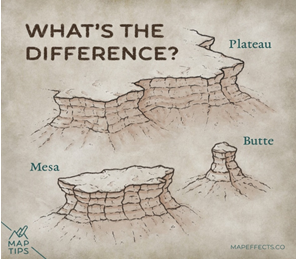
Ventifact
It is a rock or a stone that has one or more highly polished and flattened sides that is a direct consequence of sand or ice crystals driven by the wind. An example of a Martian ventifact was named Jake Matijevic.
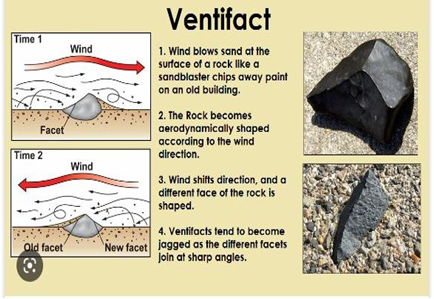
Hathi Mitras To Deal With Human Elephant Conflict In Northern Chhattisgarh
- Elephants raided crops almost every night and destroy houses and kill people.
- It not only led to financial stress in agricultural households but also human casualties.
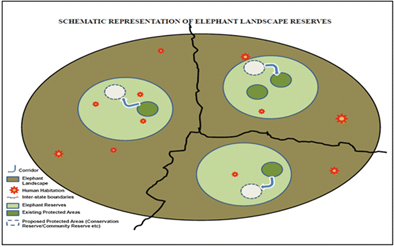

Initiative:
- HATHI MITRAS DAL were created, wherein boys from local villages patrol the affected areas.
- Ensured real time monitoring of elephants through WhatsApp groups.
- Compensation was given for damage done to crops and houses by elephants.
- Teach people to avoid encounters during village-level meetings.
- Villagers were made aware of elephant behaviour and given adequate training and tools to deal with conflict situations.

Where to use it?
Paper 2 (Government policies & Interventions)
Paper 3 (Conservation: Man, animal conflicts)
Machchhu river
|
1. Machchhu river: It originates from Madla Hills in Surendranagar district of Gujarat. It flows in north westerly direction and finally disappears near Malia in the Little Rann of Kutch. Recently, a suspension bridge collapsed over the river Machchu, in Gujarat’s Morbi district, which killed almost 135 people. |
|
2. Umiam lake: It is one of the biggest artificial lakes in Meghalaya that is situated about 15 km from Shillong. It was initially established as a dam or a reservoi,it is now a popular tourist attraction. The Meghalaya government has reportedly vowed to preserve the pristine environment of Umiam Lake. |
|
3. Surajpur Bird Sanctuary: It is situated near Surajpur Village in Dadri Tehsil of Gautam Budh Nagar district, Uttar Pradesh. It Is an excellent example of an urban wetland in Yamuna River basin. Few migratory birds have recently arrived at the site. |
|
4. Erra Matti Dibbalu: It is also called as called as Red Sand Hills, a notified National Geo-heritage Monument, situated at the outskirts of Visakhapatnam City. It is located very near to the Bay of Bengal and is one of Visakhapatnam's many heritage sites. Recently Scientists have urged Andhra Pradesh govt. to protect this site to study the impact of climate change. |
|
5. Bhupen Hazarika Bridge: Also known as Dhola Sadiya bridge, connecting Assam with Arunachal Pradesh. The bridge spans the Lohit River, a tributary of Brahmaputra. Recently, a crack has appeared on the connecting slab on Sadiya side of Dhola-Sadiya bridge. |
|
6. Unakoti: It literally means “one less one crore “, is an ancient Shavite place is a district in Tripura. Recently it has been added to the tentative list of UNESCO world heritage sites. |

Share the article
Edukemy’s Current Affairs Quiz is published with multiple choice questions for UPSC exams
MCQ
Get Latest Updates on Offers, Event dates, and free Mentorship sessions.

Get in touch with our Expert Academic Counsellors 👋
FAQs
Geography Current Affairs focuses on the contemporary issues, events, and developments in the field of geography. It covers recent geographical phenomena, environmental changes, geopolitical shifts, and related news. This differs from regular geography studies which may focus more on foundational concepts, historical contexts, and theoretical frameworks.
Updates are provided regularly to ensure that subscribers stay informed about the latest developments in geography. Typically, updates are provided on a fortnightly basis, depending on the frequency of significant events and changes in the field.
Absolutely. Geography Current Affairs serves as a valuable resource not only for Geography optional but also for GS papers, especially GS Paper 1 (covering Indian Heritage and Culture, History, and Geography of the World and Society) and GS Paper 3 (covering Technology, Economic Development, Biodiversity, Environment, Security, and Disaster Management). It aids in building a holistic understanding of various topics and strengthens answer-writing skills by incorporating contemporary examples and perspectives.
Geography Current Affairs holds immense importance for UPSC preparation, particularly for aspirants opting for Geography optional. It helps candidates stay updated with the latest developments, geographical phenomena, environmental issues, and geopolitical shifts worldwide, aligning them with the dynamic nature of the subject as tested in the UPSC examinations.


